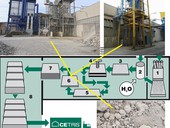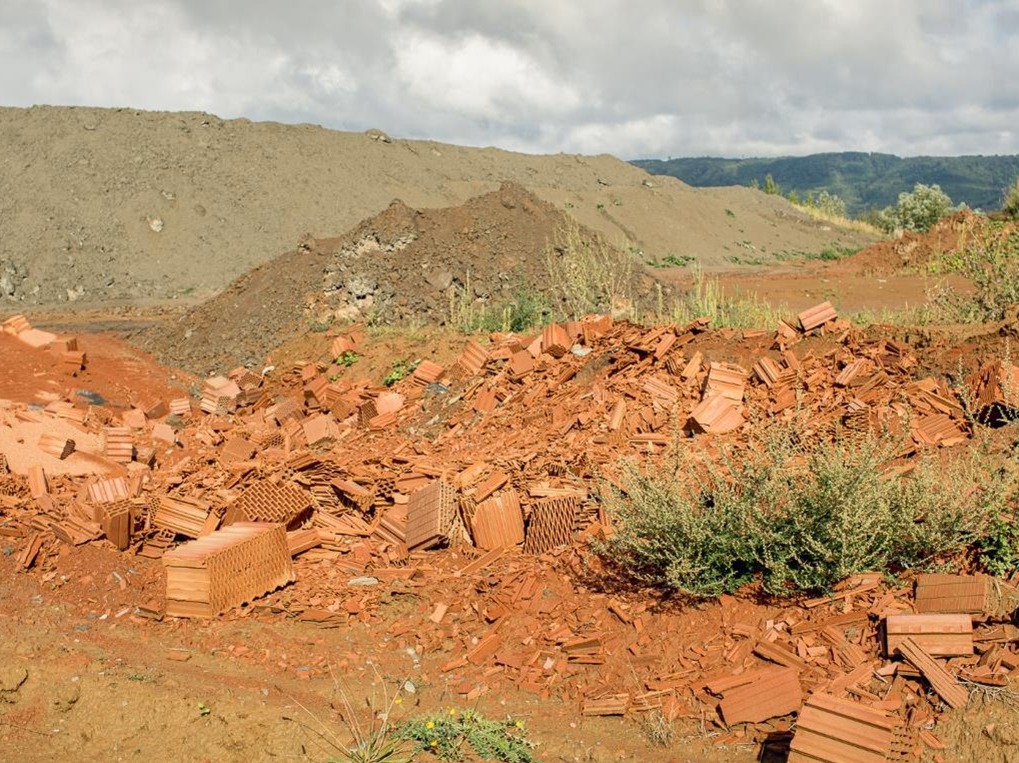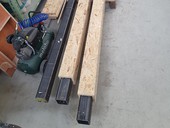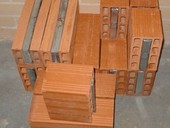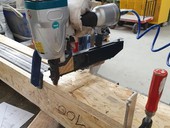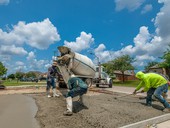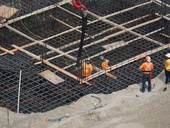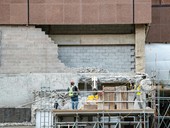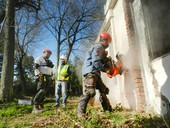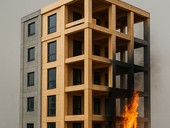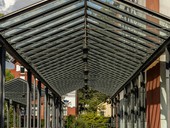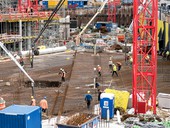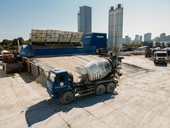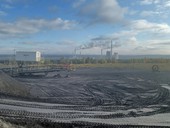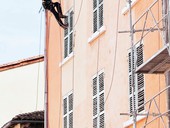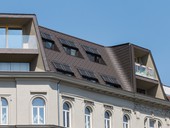The article presents research focused on a detailed analysis of cement-bonded particle boards modified with waste dust. This dust is produced during the grinding and cutting of cement-bonded particle boards. The emphasis was mainly placed on the behavior of boards with a modified composition with regard to their hygroscopicity and useful properties. The properties of three types of boards were analyzed – reference (Portland and blended cement) and dust-modified (filler and matrix – based on Portland and blended cement, substitution with waste dust in an amount of 8%). The boards were exposed to an environment with variable relative humidity (0% to 96%), with a gradient of increase and decrease of 10%. The output of this measurement is sorption curves. Subsequently, the mechanical properties (strength characteristics and modulus of elasticity) were tested on the test specimens. The obtained sorption isotherms confirmed the different behavior of individual composites in response to changes in ambient relative humidity. The results indicate that the composition of the mixture has a significant influence not only on sorption processes, but also on the stability of the wood filler itself, specifically spruce chips contained in the material. However, the behavior of the analyzed types of boards in terms of hygroscopicity is very similar. An increase in strength and modulus of elasticity was observed in all tested board variants. This finding is a positive sign for the further use of stabilized alternative raw materials in cement-bonded particle boards. The use of waste dust has significant potential to positively impact the environment, i.e., by consuming waste that would otherwise be a burden on the environment.
Archiv článků od 5.5.2025 do 15.12.2025
Recycling materials is an effective way to reduce the consumption of primary resources in construction. However, challenges arise when integrating recycled materials into construction products, primarily due to the variability of their quality, which can impact production processes. This paper explores the balance between recycling and decarbonization goals in the manufacturing of ceramic materials, examining both legislative pressures and environmental objectives. The paper emphasizes the need for optimized recycling strategies and innovative solutions that align with circular economy principles to meet sustainability targets in construction.
This article concludes a series of studies on the use of OSB claddings as passive fire protection for steel structures. Based on furnace experiments and numerical simulations (CFD and FE), OSB has been shown to significantly slow down steel heating and extend the time to reach critical temperature by up to 45 minutes. The summary highlights a paradoxical yet effective approach, where a combustible material provides protection through the formation of a char layer. The discussion addresses the main limitations, including cladding detachment, joint performance, and sensitivity to moisture. Practical applications are outlined with respect to current standards and fire codes. Finally, the article suggests directions for further research and the potential integration of wood-based materials into the normative framework as an alternative fire protection system.
The third part of the series focuses on numerical modeling of a steel beam protected by OSB cladding using the Finite Element (FE) method. The first stage involved thermal analysis, which described heat transfer in detail, included the material properties of OSB, and accounted for condition-dependent cladding detachment. The subsequent mechanical analysis, based on the thermal results, enabled assessment of deformations and load-bearing capacity of the steel member at elevated temperatures. Simulations were carried out in ANSYS Mechanical, showing good agreement with experimental data, particularly up to the moment of cladding failure. Deviations appeared in later stages, as the models did not incorporate viscoplastic steel behavior or explicit simulation of cladding failure. The study confirms that FEA modeling is a suitable tool for designing fire protection, but requires further development with advanced material models and dynamic failure simulation.
This review describes Phase Change Materials (PCMs) as an advanced solution for improving building energy efficiency and thermal comfort. It synthesizes insights into their evolution, categorization, and practical construction applications. It discusses PCMs history, operational principles, diverse typologies, and classification, including composite PCMs. It elucidates specific building applications, illustrating their integration based on recent research. The aim is to provide an overview of PCMs development and underscore their significance as a sustainable instrument for mitigating energy operating costs and elevating thermal comfort in contemporary construction. Concurrently, it delineates current obstacles and proposes strategic research directions, focusing on thermophysical property optimization, economic viability, and ecological sustainability.
Fire Protection of Steel by Timber and Wood-based Materials: Part 2 – Fire Experiment and CFD Models
The second part of the series presents a comprehensive approach to evaluating the effectiveness of OSB claddings as passive fire protection for steel beams. A large-scale furnace test demonstrated that OSB boards significantly delay steel heating until the moment of cladding failure. A single-layer cladding extended the time to critical temperature by about 17 minutes, while a double-layer system achieved up to 30 minutes. The main weakness of the system was identified at the panel joints, where premature failure occurred. A CFD model developed in FDS successfully reproduced the heating trend, especially for unprotected members and protected profiles up to the loss of cladding integrity. Deviations appeared only after cladding detachment, highlighting the need to incorporate mechanical failure into future models. The findings confirm the protective potential of OSB claddings and provide a foundation for developing design methods that account with cladding stability, joint-gaps, and time-dependent failure prediction.
This article addresses the issue of passive fire protection of steel structures using wood-based board materials, specifically OSB panels. Although steel is non-combustible, it rapidly loses its mechanical properties at temperatures above 400–600 °C and therefore requires effective fire protection. The study demonstrates that timber claddings, despite being combustible, can paradoxically slow down steel heating and extend load-bearing capacity due to the formation of a charred layer. In the experiment, beams with different OSB claddings were tested, showing that multi-layer systems can increase fire resistance by several tens of minutes. These findings were further validated by numerical modeling (CFD and FE analyses), enabling a detailed description of heat transfer, pyrolysis processes, and structural response. The study provides a methodological basis for the design and assessment of timber claddings as an alternative fire protection system for steel members, emphasizing safety, architectural integration, and sustainability.
The paper focuses on the issue of returnable dust content generated during the production of hot asphalt mixtures in asphalt plants, which represents a long-standing unresolved problem in waste material management. It describes the current state of solutions to this issue, including an overview of legislative and technical requirements related to the utilization of returnable dust. The article deals with the specification of returnable dust quantities in individual narrow aggregate fractions and their potential usability. The next part includes verification of the applicability of returnable dust in cement mortar used for grouting layers partially stabilized with cement mortar. Laboratory tests were conducted to examine the mechanical properties of these mortar mixtures and their suitability for construction applications.
The second generation of the design standard, FprEN 1992-1-1:2023, allows for the use of fibre-reinforced polymer (FRP) reinforcement in structural concrete for the first time in Czech design practice. Reinforcement made of glass (GFRP) or carbon fibre (CFRP) is a promising alternative, especially in environments with high demands for corrosion resistance. The reinforcement is non-conductive and non-magnetic and is therefore suitable for areas with shielding requirements against the electromagnetic waves. Compared to steel, however, GFRP has a lower modulus of elasticity and a linear response to imposed loads up to failure, which requires a different approach to structural sizing. The new standard defines a relationship for determining the design punching shear capacity of a slab with longitudinal FRP reinforcement but does not allow the FRP to be used as shear reinforcement. This paper presents experimental results from slabs reinforced with both traditional steel and FRP reinforcement. Selected specimens also included FRP stirrups to assess their effect on punching shear capacity. The experimental results are compared with predictions based on both the first and second generation of the Eurocode.
Reducing the environmental footprint of concrete is crucial for sustainable construction. This paper explores circular economy strategies such as reusing existing structures, recycling concrete and mineral waste, and substituting cement with secondary raw materials. A case study evaluating over 100 concrete mixes (C10/15–C30/37) compared natural and recycled brick aggregate, as well as six types of blended cements (CEM II). Mechanical properties and environmental impacts were assessed using LCA in five impact categories. Results highlight the effectiveness of secondary materials in reducing CO₂ emissions and overall environmental burden.
Pre-demolition audits help identify materials suitable for reuse or recycling, thereby reducing the volume of construction and demolition waste and supporting the principles of the circular economy. The article presents the legal framework, audit methodology, and the environmental and economic benefits of such audits. It also includes current insights and practical examples from the European project CIRC-BOOST (Horizon Europe), which tests and implements circular solutions in construction through pilot projects in five countries.
The article summarizes aspects of fire safety in hybrid structures using wood. It highlights the limited applicability of existing standards when combining materials with different thermal and mechanical properties and emphasizes the need for a fire engineering approach. Based on casestudies, including the Moen-Wood system from the Japanese company Takenaka, approaches such as layered structures and controlled charring are presented. The article provides an overview of current design options and identifies challenges faced by Czech design practice in the design of fire-resistant timber structures for higher buildings.
The paper deals with the numerical calculation of a steel joint at elevated temperature. The Sheffield experiment, well known and described in the literature, has been studied. The study of the shell model has been carried out using the (CBFEM). The validation of the model shows good agreement with the experiment. A summary of the sensitivity study is included in the paper.
This study explores the potential of a calcined kaolinite-illite clay in LC3-type binders with the aim of assessing the material’s thermal resistance. After designing and characterizing the binder compositions, simultaneous thermal analysis (STA) was used to identify critical temperature ranges of phase transformations. Three key regions were detected: 50–300 °C (dehydration), 400–500 °C (Portlandite decomposition), and 650–750 °C (CaCO3 decarbonation). Between these, the material remained thermally stable. Based on this, 400, 600, and 1000 °C were selected as target temperatures for future heat exposure tests. The presented results form the basis for further investigation of the high-temperature behavior of this alternative cementitious system.
In 2015, the preparation of a new generation of the Eurocodes was initiated, with the implementation in Slovakia anticipated by 2028. The notable update introduced in the Eurocode 2 is a revised methodology for the design of the anchorage of reinforcing steel in concrete structures. This article presents a comparative analysis of the design approaches and the required anchorage lengths specified in the current and upcoming version of the Eurocodes 2.
This paper deals with the use recyclate as a partial or complete substitute for natural aggregates for the production of concrete. However, the current legislation in the EU and the Czech Republic allows this use only to a very limited extent. The text will describe the current situation in the Czech Republic and the directions of further development of related standards to extend the existing possibilities of using recyclates for concrete production.
The aim of the methodology is to establish a procedure for the safe use of fly ash from coal combustion in construction products. The development of this methodology was part of project no. FW01010195, titled “Advanced Manufacturing Technologies for the Strategic Utilization and Storage of By-Products of Energy Production (BEP)”. The methodology is intended to serve as a basis for decision-making regarding the handling of these materials for companies engaged in the production of construction products containing fly ash, state administration officials, the Czech Environmental Inspectorate (ČIŽP), certification bodies, regulatory authorities, and other relevant stakeholders.
This article focuses on the composition and restoration of plasters of historical buildings, carried out since the 20th century, especially from its second half until today. The binders, admixtures, and additives used for plasters in the past are described, and the differences in their properties compared to those of current materials are discussed. The principles of plaster restoration using various methods of preparing plaster mortar mixtures are described. Attention is also paid to the types and properties of plasters for damp masonry containing water-soluble salts. Disagreeing opinions on restoration from the perspective of architectural heritage care and technologists are also discussed.
This article focuses on the composition and restoration of plasters of historical buildings, carried out since the 20th century, especially from its second half until today. The binders, admixtures, and additives used for plasters in the past are described, and the differences in their properties compared to those of current materials are discussed. The principles of plaster restoration using various methods of preparing plaster mortar mixtures are described. Attention is also paid to the types and properties of plasters for damp masonry containing water-soluble salts. Disagreeing opinions on restoration from the perspective of architectural heritage care and technologists are also discussed.
The second and final part of the article on the design of loft extensions and superstructures in masonry buildings deals with other possibilities of increasing the load-bearing capacity of existing wooden floor structures. It also discusses the reinforcement of reinforced concrete ceilings and ceiling structures with rolled steel profiles. Finally, the possibility of increasing the clear height of the loft space and the special features of superstructures.
zpět na aktuální články
